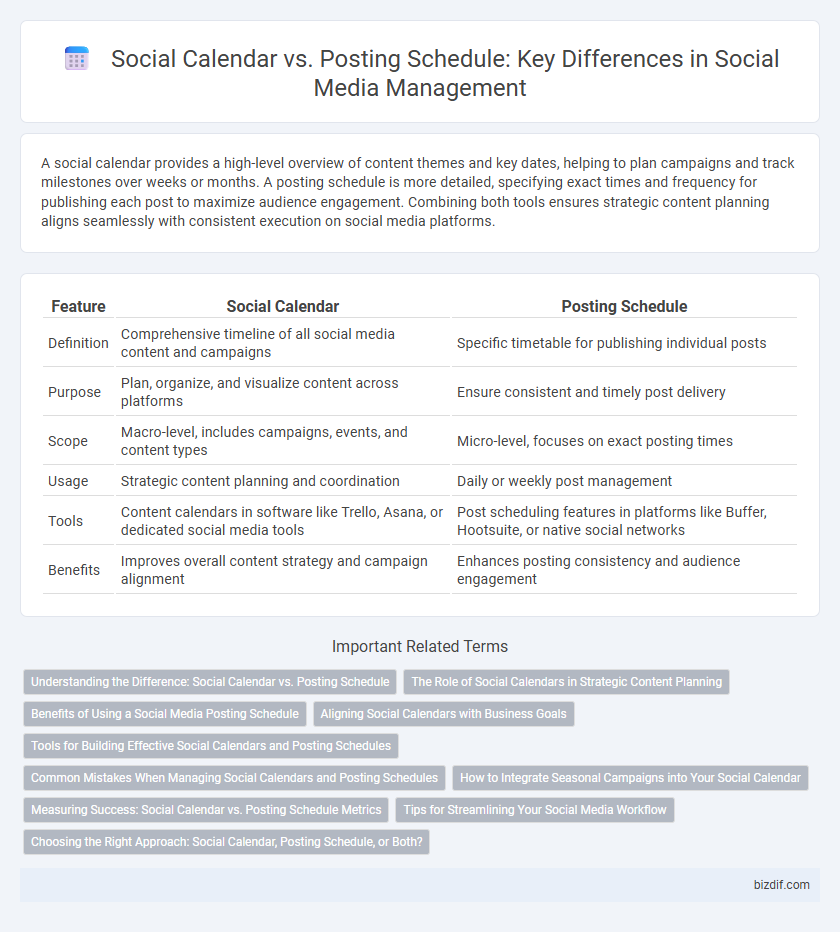A social calendar provides a high-level overview of content themes and key dates, helping to plan campaigns and track milestones over weeks or months. A posting schedule is more detailed, specifying exact times and frequency for publishing each post to maximize audience engagement. Combining both tools ensures strategic content planning aligns seamlessly with consistent execution on social media platforms.
Table of Comparison
| Feature | Social Calendar | Posting Schedule |
|---|---|---|
| Definition | Comprehensive timeline of all social media content and campaigns | Specific timetable for publishing individual posts |
| Purpose | Plan, organize, and visualize content across platforms | Ensure consistent and timely post delivery |
| Scope | Macro-level, includes campaigns, events, and content types | Micro-level, focuses on exact posting times |
| Usage | Strategic content planning and coordination | Daily or weekly post management |
| Tools | Content calendars in software like Trello, Asana, or dedicated social media tools | Post scheduling features in platforms like Buffer, Hootsuite, or native social networks |
| Benefits | Improves overall content strategy and campaign alignment | Enhances posting consistency and audience engagement |
Understanding the Difference: Social Calendar vs. Posting Schedule
A social calendar provides a comprehensive overview of all planned content, campaigns, and events across platforms, helping teams visualize long-term strategies and key dates. In contrast, a posting schedule specifies exact times and frequencies for individual posts to maximize engagement based on audience analytics. Understanding the difference between these tools enhances workflow efficiency and ensures consistent, strategic content delivery.
The Role of Social Calendars in Strategic Content Planning
Social calendars serve as comprehensive tools in strategic content planning by mapping out thematic campaigns, key dates, and audience engagement goals, ensuring a cohesive brand narrative across all social channels. Unlike posting schedules that focus solely on timing and frequency, social calendars integrate content types, target demographics, and platform-specific strategies to optimize reach and impact. Effective use of social calendars enables marketers to anticipate trends, coordinate cross-functional teams, and maintain consistent messaging aligned with broader business objectives.
Benefits of Using a Social Media Posting Schedule
A social media posting schedule enhances consistency by planning posts at optimal times to maximize engagement across platforms like Instagram, Facebook, and Twitter. This organized approach improves audience targeting and streamlines content creation, reducing last-minute stress and increasing efficiency for marketing teams. Leveraging tools like Hootsuite or Buffer within a posting schedule also enables detailed analytics tracking, helping brands refine their strategies based on performance data.
Aligning Social Calendars with Business Goals
Aligning social calendars with business goals ensures content delivery supports strategic objectives and maximizes audience engagement. A social calendar provides a holistic overview of campaigns, events, and key dates, fostering cohesive storytelling across platforms. In contrast, a posting schedule fine-tunes timing and frequency, optimizing reach and interaction based on analytics and target audience behavior.
Tools for Building Effective Social Calendars and Posting Schedules
Effective social media management relies on tools like Hootsuite, Buffer, and Sprout Social to build robust social calendars and posting schedules. These platforms enable users to plan content by date, track engagement metrics, and automate posting times tailored to audience activity patterns. Integrating analytics tools such as Google Analytics and native insights from Facebook and Instagram further refines the scheduling process for optimized reach and consistency.
Common Mistakes When Managing Social Calendars and Posting Schedules
Social calendar and posting schedule management often suffers from inconsistent timing and unclear content objectives, which reduce audience engagement and brand coherence. Common mistakes include neglecting to align posts with key dates and failing to maintain flexibility for trending topics or real-time responses. Overloading schedules without analytic review can also lead to follower fatigue and diminished social media ROI.
How to Integrate Seasonal Campaigns into Your Social Calendar
Integrating seasonal campaigns into your social calendar requires aligning key holidays, events, and seasonal trends with your content planning to maximize engagement and relevance. Plan posts and promotions around major dates such as Black Friday, Christmas, and summer sales, while adjusting frequency in your posting schedule to maintain consistent interaction without overwhelming followers. Use data analytics to track previous seasonal campaign performance and optimize timing, content types, and posting frequency within your social calendar for improved ROI.
Measuring Success: Social Calendar vs. Posting Schedule Metrics
Measuring success in social media management involves analyzing distinct metrics from both social calendars and posting schedules to optimize performance effectively. Social calendar metrics focus on long-term engagement trends, campaign alignment, and content variety distribution, while posting schedule metrics emphasize post frequency, peak engagement times, and immediate interaction rates. Combining insights from these metrics enables data-driven decisions to enhance audience reach and content impact.
Tips for Streamlining Your Social Media Workflow
Creating a detailed social calendar helps visualize content themes and campaign timelines, while a posting schedule specifies exact times for publishing each post across platforms. Integrating both tools enables efficient planning and consistent engagement by aligning content creation with optimal posting times based on audience analytics. Use automation software to sync calendars and schedules, reducing manual updates and ensuring a seamless, streamlined social media workflow.
Choosing the Right Approach: Social Calendar, Posting Schedule, or Both?
Selecting the right approach between a social calendar and a posting schedule depends on your content strategy and team dynamics. A social calendar offers a high-level overview of campaigns and key dates, ideal for long-term planning and coordination across platforms, while a posting schedule focuses on the specific timing and frequency of posts for consistency and audience engagement. Combining both tools enhances strategic foresight and operational efficiency, ensuring timely content delivery aligned with broader marketing goals.
Social calendar vs Posting schedule Infographic

 bizdif.com
bizdif.com